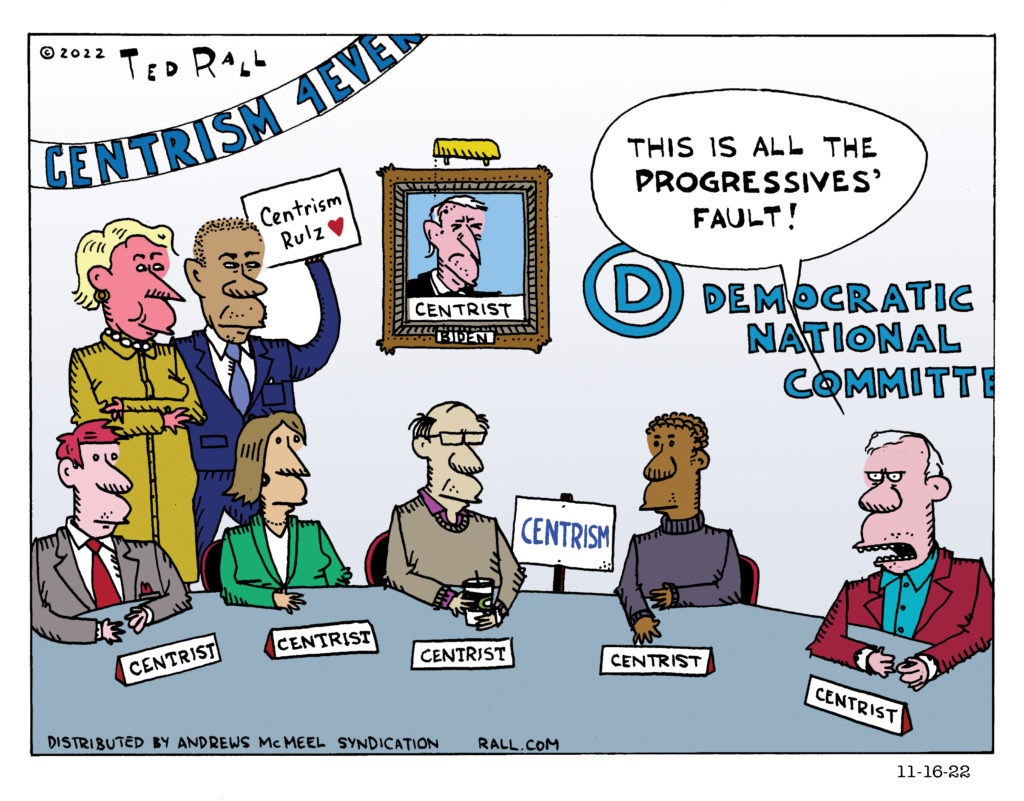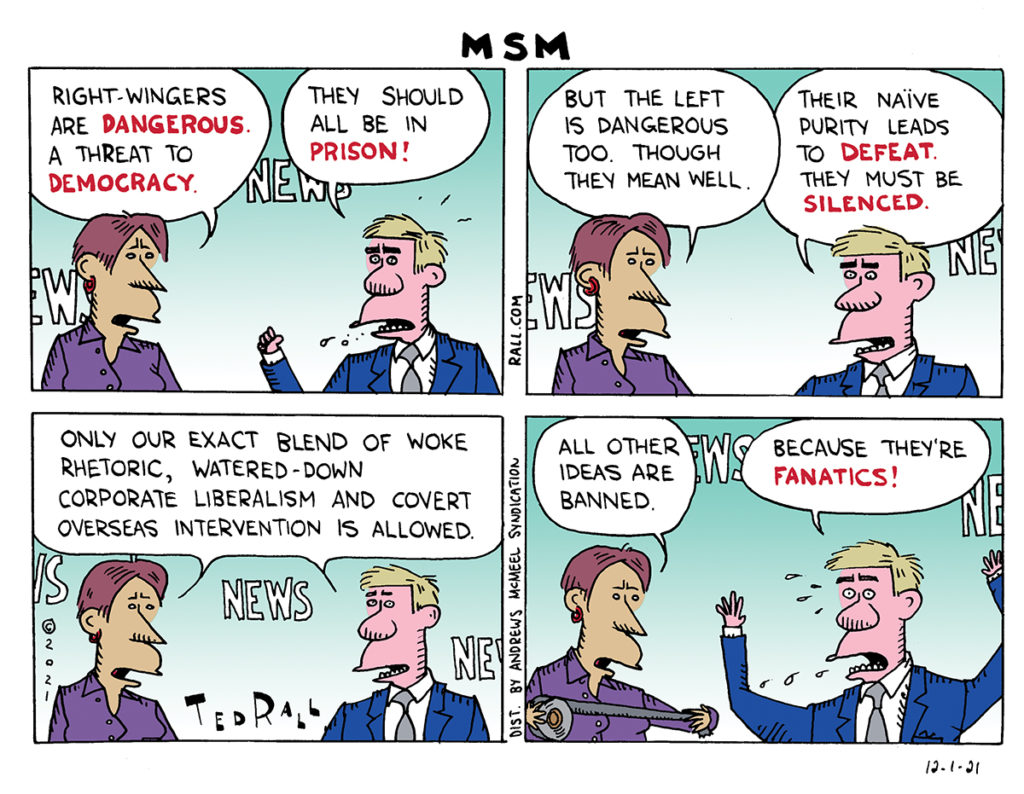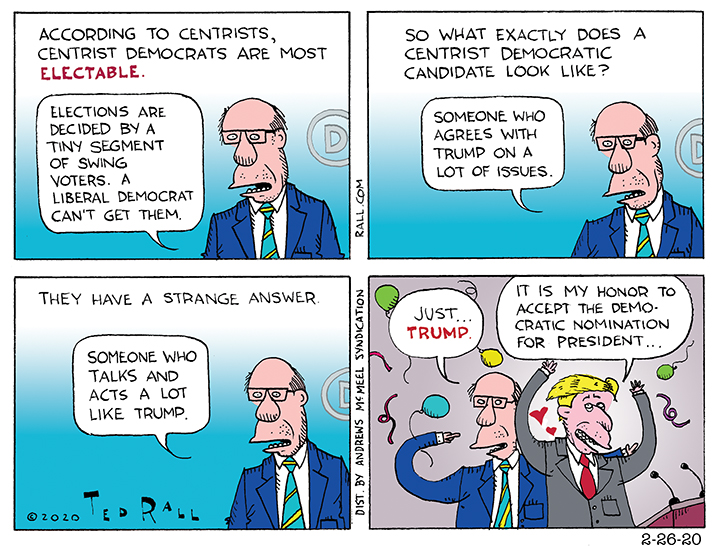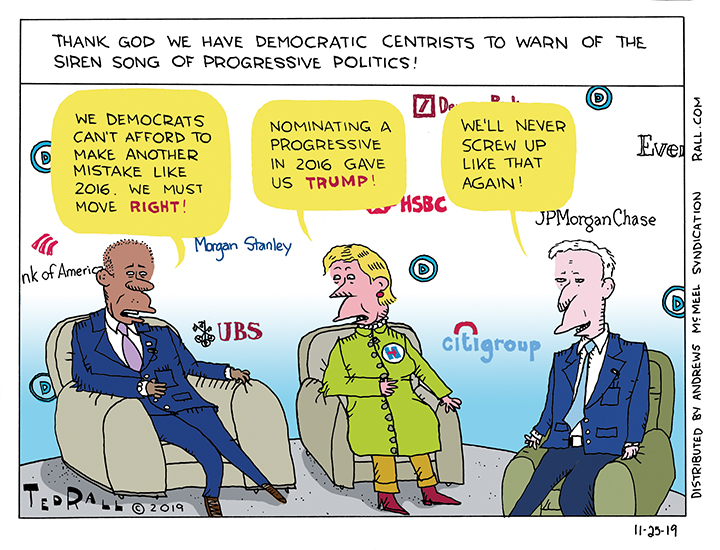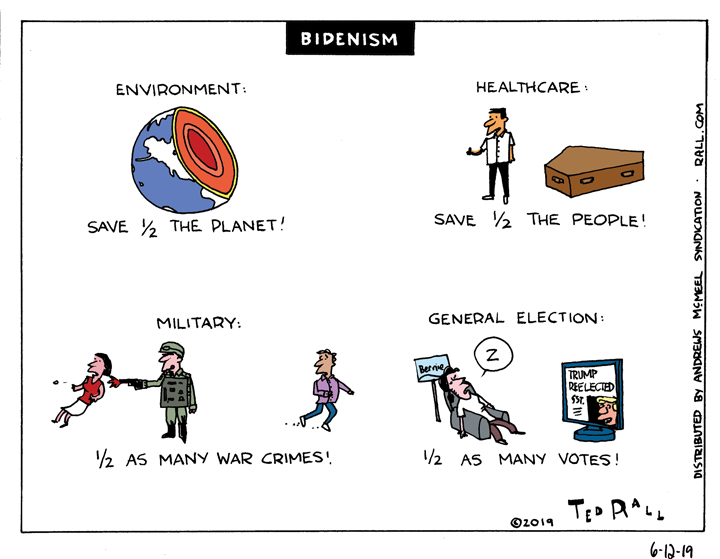As Democrats size up their losses and the future of the party, the last thing they consider is the possibility that they might bear some responsibility for discontent leading into the 2022 midterm elections. As usual, there’s a convenient whipping boy. As usual, the criticism couldn’t possibly be less justified.
MSM
Political centrists, including those who run the mainstream corporate media, position themselves as reasonable and more rational than proponents of ideas to their left or to the right. But the militant moderates are fanatics in their own right, closed to any possibility that they might be mistaken and willing to ruthlessly crush opposing views.
In a Crisis, a Compromise Solution Is Worse Than No Solution at All
The raging argument on the left between progressives who argue for radical change and centrists who advocate incrementalism is hardly new. Nearly a century ago, progressive titan and Wisconsin governor Robert La Follette and FDR were often at loggerheads over the same question.
Roosevelt, La Follette complained, was too quick to compromise with reactionaries. FDR insisted that “half a loaf is better than no bread.” While that might seem intuitively obvious, La Follette had a ready reply. “Half a loaf, as a rule, dulls the appetite, and destroys the keenness of interest in attaining the full loaf.” That can be dangerous. The average adult male requires approximately 2500 calories of nutrition per day. 1250 is better than 0, but 1250 is still malnutrition that would eventually kill him.
Even in a long-running crisis, the sustained agitation necessary to pressure the political classes into granting concessions doesn’t usually occur before people’s suffering has become acute. If the powers that be provide partial relief in the form of a half-measure that partly alleviates a problem, angry citizens can be persuaded to put down their pitchforks and go home peaceably. Yet the problem persists.
The Affordable Care Act is a perfect example. Obama became president at the peak of a major economic crisis, the subprime mortgage meltdown of 2007-09. With hundreds of thousands of people losing their jobs every month, the need for government intervention in the healthcare system was obvious to most Americans. So Obama campaigned on major change that included a public option. Two out of three people, including many Republicans, favored a single-payer system similar to those in many other countries.
Instead, we got the watered-down ACA.
As COVID-19 has made clear, the for-profit American healthcare system is even more scandalously dysfunctional than it was prior to the passage of Obamacare. The ACA “marketplace” has collapsed; many places only offer one “take it or leave it” insurance plan. Nevertheless, healthcare is no longer a top political issue. Support for a public option or Medicare For All has dropped to about 50%. The Democratic Party chose to nominate someone who promised to veto Medicare For All even if both houses of Congress were to pass it.
Tens of thousands of people are still dying every year because they can’t afford to see a doctor. But in too many people’s minds, healthcare was partly solved. So they are no longer demanding improvements. Though it might seem counterintuitive, the politics of the healthcare crisis would be vastly improved had the compromise ACA never been enacted. More people would be suffering. But the absence of an existing, lame, plan would add urgency (and supporters) to the fight for a real, i.e. radical, solution.
Half a loaf is killing us.
As Joe Biden fills his cabinet with Obama-era centrists and corporatists, many Democrats say they are satisfied with the improvement over Trump: officials with government experience replacing crazies and cronies, pledges to reverse the outgoing administration’s attacks on the environment, fealty to science. They are falling into La Follette’s “half a loaf” trap. Especially on existential issues like climate change but also regarding the precarious state of the post-lockdown economy, compromise will sate the appetite for meaningful change without actually solving the problems. As with the ACA, voters will be deceived into thinking things are getting better when in fact they will still be getting worse, albeit perhaps at a slightly slower rate.
Climate scientists are divided between those who say we might be able to save human civilization if we achieve zero net carbon emissions within a decade (which is the goal of the Green New Deal pushed by progressives), and those who say it’s already too late. A widely reported study predicts that human civilization will collapse by 2050, yet that’s the year Biden is promising to begin zero net carbon emissions. So if we do what Biden wants, we are going to die.
Trump denied climate science, deregulated polluters and pulled the U.S. out of the Paris Accord. Biden appears to be an improvement. He talks about the urgency of the problem, promises to restore Obama-era regulations and to rejoin the Paris Agreement. Pro-environment Democratic voters are breathing a sigh of relief.
But if the goal is to slow the rate of global warming as much as we reasonably can, both Obama’s regulations and the Paris Agreement are woefully inadequate. “Marginal cuts by the U.S. don’t have a long-term overall big effect on the climate,” Michael Oppenheimer, professor of geosciences and international affairs at Princeton University, told Scientific American in 2014.
A 2017 report by the United Nations Environment Program found that “if action to combat climate change is limited to just current pledges, the Earth will get at least 3°C (5.4°F) warmer by 2100 relative to preindustrial levels. This amount of warming would vastly exceed the Paris Agreement’s goal, which is to limit global warming by the end of the century to 2°C (3.6°F),” reported National Geographic.
“[3°C increase] would bring mass extinctions and large parts of the planet would be uninhabitable,” the UNEP warned in 2019.
If liberals head back to brunch in a month thinking that the Biden Administration will move the needle in the right direction, if they stop being terrified, we are doomed. For as bizarre as it sounds, Donald Trump provided a valuable service when he scared the living daylights out of us.
Consider a more modern analogy than the loaf of bread: if a two-pill dose of antibiotics is required to cure an illness, taking one instead doesn’t make you half better. It actually makes you worse because not only do you not get better, you destroy your immune system’s ability to fight the disease.
This country is teetering on the verge of collapse. We can’t afford to settle for the single-pill solutions of incremental Bidenism.
(Ted Rall (Twitter: @tedrall), the political cartoonist, columnist and graphic novelist, is the author of “Political Suicide: The Fight for the Soul of the Democratic Party.” You can support Ted’s hard-hitting political cartoons and columns and see his work first by sponsoring his work on Patreon.)
Joe Biden Will Be a Republican President
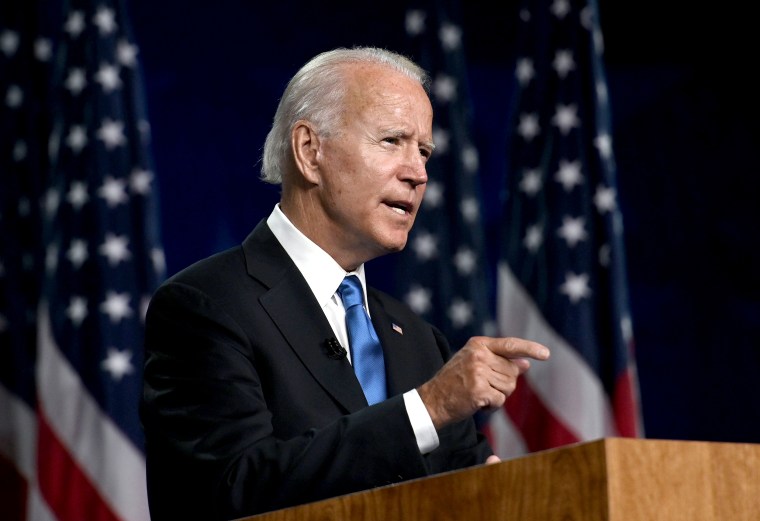
Past performance is no guarantee of future returns but there are few more reliable ways to predict what comes next than to examine the historical record because, most of the time, history really does repeat.
What kind of president would Joe Biden be? His centrist supporters assure progressives that he will be one of them, pushing an aggressive legislative agenda reminiscent of FDR’s New Deal. His Republican opponents portray him as a socialist. But Biden hasn’t actually promised anything ambitious.
The last two Democratic presidencies provide a good indication of what a Biden Administration would look like. Like Biden, Bill Clinton and Barack Obama hail from the centrist party establishment. If personnel is policy, the three men hang out with many of the same advisors, businesspeople and elected officials. They’re not identical: Clinton is a charismatic retail politician, Obama is aloof and professorial, and Biden is an LBJ-style buttonholer minus Johnson’s secret idealism. But they’re ideologically and temperamentally similar to a remarkable extent.
I remembered Clinton and Obama as deeply disappointing to voters with traditional liberal Democratic values. I remembered that most of their major legislative accomplishments would not have been out of place under a Republican administration.
When I checked the historical record recently, however, it was even worse than I remembered.
Clinton used his political capital to push through free trade deals like NAFTA and the WTO, which killed manufacturing jobs and drove the final nails into the coffin of big labor. He “ended welfare as we know it,” making it even more difficult for people who lost their jobs to get back on their feet and adding the chronically poor to the ranks of the homeless. Clinton signed Joe Biden’s now infamous 1994 crime bill into law, codifying a racist judicial system that disproportionately punishes black men for relatively minor offenses.
Clinton repealed the 1930s-era Glass-Steagall Act, banking deregulation set the stage for banks to wallow in the reckless predatory lending practices that tanked the global economy in 2008-09.
His most impressive achievement was balancing the federal budget and paying off the deficit, but he didn’t do it by raising taxes on the rich. He imposed austerity on social programs—just like a Republican would do.
I searched hard for Clintonian achievements that could credibly be called liberal or at least left of center, but aside from a few minor regulations here and there, there aren’t any. “So we liberals and radicals searched the Clinton administration for vast new programs to applaud. But nothing loomed into view,” Paul Berman wrote in The New Republic at the end of Clinton’s presidency in 2000. Clinton was a moderate Republican president.
In some ways—especially foreign policy—Obama was even worse. Clinton bombed with the bloody relentlessness of a Reagan or a Bush: Bosnia, Sudan, Afghanistan and, forgotten now, Iraq so much and so often that pilots dumped their bombs in the desert to cover for the fact that they were running out of fresh targets. His sanctions stopped everything, including medical supplies, from entering Afghanistan. But he had nothing on Obama.
After Col. Muammar Gaddafi signed a peace deal with Bush that ended Libya’s nuclear program, Obama assassinated him with a drone, plunging that nation into a bloody civil war. Thanks to Obama, Libya, formerly the most literate and prosperous country in Africa, is now a failed state where slavery has been restored. Obama similarly wrecked Syria, where he also funded and armed jihadi extremists against secular socialist leaders. Obama radically expanded Bush’s drone program, kept Gitmo open, effectively pardoned Bush’s torturers, expanded the USA-Patriot Act and NSA spying on your phone calls and emails.
With Democrats like these, you don’t need Republicans!
For liberals, there is one relatively bright spot in these 16 years of Democratic rule: the Affordable Care Act. Obamacare was the first major health-sector reform in decades and brought coverage to tens of millions of patients, most beneficially via Medicaid expansion.
Let’s face it. The last two Democratic presidents didn’t really govern like Democrats. Compare the ACA to the achievements of Republican presidents like Ronald Reagan, George W. Bush and Donald Trump. Republicans push through huge changes when they are in office.
And I’m not even going to point out—well, yes I am—that Obamacare was conceived by the right-wing Heritage Foundation.
As I wrote at the beginning of this essay, what happened under Clinton and Obama won’t necessarily be replicated by Joe Biden. But it almost certainly will be.
There’s a reason Biden considered picking a Republican running mate and a reason Republicans are endorsing him and a reason he gave Republicans more speaking time at the Democratic National Convention than AOC—he’s one of them, not one of us.
(Ted Rall (Twitter: @tedrall), the political cartoonist, columnist and graphic novelist, is the author of the biography “Political Suicide: The Fight for the Soul of the Democratic Party.” You can support Ted’s hard-hitting political cartoons and columns and see his work first by sponsoring his work on Patreon.)
Why We Need a New Progressive Party and How We Can Create It

There is no room for progressives in the Democratic Party.
No matter how many votes he or she gets, no progressive will be permitted to be the presidential nominee of the Democratic Party.
Progressives who try to work inside of, contribute to and support the Democratic Party have no real chance of moving its candidates or policies to the left.
Remaining inside the Democratic Party achieves nothing; to the contrary, it is insidiously counterproductive. Working for “change from the inside” strengthens centrist politicians who oppose progressivism with every fiber of their being.
If American electoral democracy has a future, and progressives want to be part of that future, there is only one way forward: create and build a new party in which progressivism isn’t merely tolerated or partly accommodated as some fringe or necessary nuisance but is its core mission.
We need a New Progressive Party.
The reason is simple: progressivism and corporate centrism are not parts of an ideological spectrum. Centrism isn’t watered-down progressivism; centrism directly opposes progressivism. Centrists want wars and don’t care about the poor; progressives want no wars and care deeply about the poor. There is no room for compromise between the two.
A New Progressive Party will go nowhere if, like the Green Party, it is poorly funded and disorganized and unable to field a slate of candidates across the board, from city council to state representative to congress. It must begin robustly, it must grow quickly, and it must be the only viable outlet for real progressives. Go big or go home.
This could be done. Now is the perfect time.
Keep reading. I’ll explain how.
Anyone who believes progressives have a place inside the Democratic Party should reflect on the experience of Bernie Sanders. (Those with an interest in recent history can delve into the dispiriting experiences of others who have tried to move the party left from the inside like Ted Kennedy, Jesse Jackson and Howard Dean, only to be ignored, snubbed and cheated.)
In both 2016 and 2020 Democratic-aligned media companies marginalized, misrepresented and deprived Sanders of coverage proportionate to his level of support in the polls. In 2016 the Democratic National Committee literally sold itself to Hillary Clinton’s center-right campaign apparatus, which conspired with the DNC to short Sanders on vote counts and deprive him of access to party data. In 2020 the DNC appears to have derailed Sanders’ frontrunner status by arranging for candidates Pete Buttigieg, Beto O’Rourke, Amy Klobuchar and others to drop out and endorse the Joe Biden one day before the key Super Tuesday primaries.
This is not one of those “better luck next time” scenarios. Sanders is too old to run again. AOC and her fellow progressive Squad are too young to mount a serious challenge to the DNC moderate hierarchy any time soon. Progressivism inside the Democratic Party is unlikely to again surge to Bernie levels for at least a decade.
Progressivism in general remains vibrant. Bernie Sanders has 31% of the 2020 primary popular vote. Elizabeth Warren, who has withdrawn, has 10%. Even if we assume that other former candidates like Pete Buttigieg didn’t get a single progressive vote — which isn’t likely — at least 41% of Democratic primary voters currently support progressivism. That makes about 20% of the electorate overall. Roughly 20% of non-voters, or about 9% of the total electorate, are progressive.
A New Progressive Party should therefore be able to count on roughly one of five voters out of the gate, with short-term potential of 30%. Not bad in a three-party system.
Now consider two factors that point to growth. As even corporate media concedes, progressive ideas like socialized medicine and a guaranteed living wage have suddenly exploded in popularity due to the coronavirus crisis and resulting economic freefall. Given the grim projections for the economy during the foreseeable future, 20-to-30% looks more like a floor than a ceiling.
There is greater potential of building a party from the grassroots than from the top down. Even while the presidency remains elusive, local politics are quirkier and thus offer opportunity for growth. Sanders began as mayor of Burlington; AOC won a surprise challenge to a long-time incumbent Democratic congressman in Queens. A Progressive farm team could and would spring up quickly in left-leaning college towns like Madison and Charlottesville.
But how? The D-R duopoly has rigged the system in its favor. Ballot access is tough. They control the presidential debates and coverage by the news media.
As I wrote above, funding is crucial. The fact that Bernie Sanders raised over $100 million so far in 2020 from small donors proves that progressives can raise cash for a cause they care about. So how do you start this new party?
The first step is to convene a founding meeting in a big venue like McCormick Place Convention Center. (Chicago is easy to get to from everywhere in the U.S.) Launch a Kickstarter to cover the cost of renting the hall; unless there are enough pledges to cover the total, no one has to pay up and the attempt is over. It serves as the first test of whether enough progressives are ready to break away from the Democratic Party.
The agenda of the first convention of the New Progressive Party will be dedicated to debating and agreeing to a platform, electing party officials and setting a strategy for the next election.
The newly-elected officials of the party then fan across the nation and start building local organizations in their own communities to recruit, fund and campaign for candidates to local and state office. Like the Democrats and Republicans, every four years there will be a national primary and convention to present a candidate for the presidency.
Some will argue that the creation of a party just for progressives will split the left. That assumes that the Democratic Party represents the left. The truth is exactly the opposite: the Democratic Party is where the American left goes to die. If the left wants to live, it must fight and struggle for the things that it cares about on its own, in its own home.
(Ted Rall (Twitter: @tedrall), the political cartoonist, columnist and graphic novelist, is the author of the biography “Bernie.” You can support Ted’s hard-hitting political cartoons and columns and see his work first by sponsoring his work on Patreon.)

